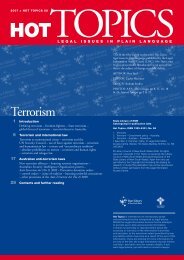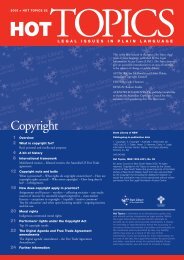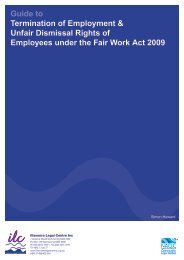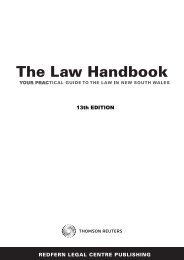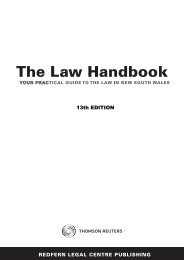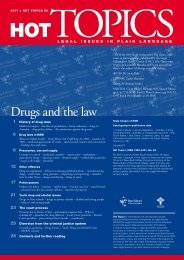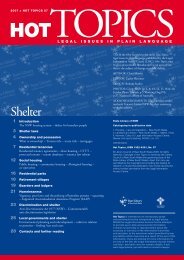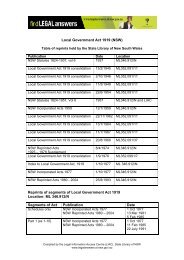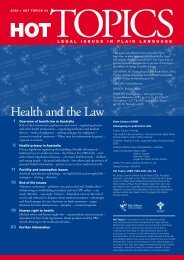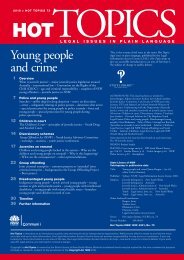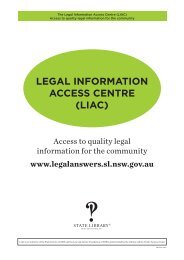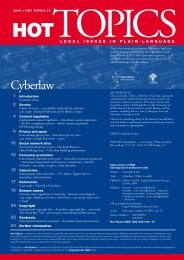Hot Topics - Issue 65: Human Rights - Legal Information Access ...
Hot Topics - Issue 65: Human Rights - Legal Information Access ...
Hot Topics - Issue 65: Human Rights - Legal Information Access ...
You also want an ePaper? Increase the reach of your titles
YUMPU automatically turns print PDFs into web optimized ePapers that Google loves.
to family violence and child abuse. The measures<br />
introduced by the Government include:<br />
> alcohol restrictions<br />
> ‘quarantining’ welfare payments into Government<br />
control to ensure the money intended for children’s<br />
welfare is spent on the children<br />
> linking welfare payments to school attendance<br />
> health checks<br />
> changing community living arrangements to resemble<br />
private market tenancies<br />
> banning pornography<br />
> scrapping the permit system that allowed Aboriginal<br />
people to control access to their lands.<br />
The legislation that introduced this package of reforms<br />
specifically suspended the operation of the Racial<br />
Discrimination Act 1975 (Cth) and, in the alternative,<br />
the legislation explicitly states that that the intervention<br />
is protected by the Act as a ‘special measure’, that is, a<br />
measure that benefits Indigenous people and should not<br />
be considered to be unlawfully discriminatory.<br />
The Social Justice Commissioner’s Social Justice<br />
Report calls for the reinstatement of protections against<br />
discrimination, and for the re-engagement with and<br />
fostering of participation by Indigenous people as<br />
partners with government in the process of protecting<br />
children. The Commissioner takes a human rights<br />
approach by emphasising a methodology that begins<br />
with the participation and direction of the policy<br />
response by those affected by the policy, the Indigenous<br />
people themselves.<br />
refuGees and HuMan riGHTs<br />
Australia is a party to the 1951 Convention Relating<br />
to the Status of Refugees, and the 1967 Protocol to the<br />
Convention. Australia’s obligations under those treaties<br />
have been given domestic effect in the Commonwealth<br />
Migration Act 1953. A person seeking refugee status (an<br />
‘asylum seeker’) under the Convention must establish a<br />
well-founded fear of persecution in their own country on<br />
the basis of their race, religion, nationality, membership<br />
of a social group, or political opinion.<br />
The controversy in Australia in the later part of 2001,<br />
and particularly in the weeks leading up to the Federal<br />
election in November of that year, focused on asylum<br />
seekers who arrived on Australian territory by boat from<br />
Indonesia. The issue was put in terms of ‘legality’ and<br />
‘border protection’. From a human rights perspective, the<br />
legality of asylum seekers’ presence in Australian territory<br />
derives from the right in the Universal Declaration of<br />
<strong>Human</strong> <strong>Rights</strong> ‘to seek … in other countries asylum<br />
from persecution’. Whether an asylum seeker is actually<br />
a refugee can then be determined according to the<br />
Migration Act.<br />
Responding to the phenomenon of boats arriving<br />
from Indonesia, the Australian Government passed<br />
laws which, among other things, limited the extent<br />
of Australia’s compliance with its obligations under<br />
the Refugee Convention, redefining the meaning of<br />
‘persecution’ inconsistently with international law.<br />
In 2001, the Australian Government significantly<br />
changed the way in which Australia implements the<br />
Refugee Convention. Two of the many changes to the<br />
Migration Act relate to the definition of ‘refugee’, and to<br />
the application of the Migration Act in Australia.<br />
Australia no longer uses the internationally recognised<br />
concept of ‘well-founded fear of persecution’ as a basis<br />
for identifying a refugee. Instead, Australia has limited<br />
the effect of the Refugee Convention. Australia requires<br />
an asylum seeker to prove that the reason for their fear<br />
of persecution is ‘the essential and significant reason’<br />
for their fear. As well the person must prove that the<br />
persecution involved ‘serious harm to the person’, and<br />
‘systematic and discriminatory conduct’. According to<br />
many commentators, these requirements do not exist in<br />
international law.<br />
Further, the extent to which Australia has given ‘domestic<br />
effect’ to the Convention has been limited: the Migration<br />
Act does not extend in its operation to prescribed parts<br />
of Australia, including those parts such as Christmas<br />
Island where some asylum seekers have been arriving.<br />
The Rudd Government announced the closure of<br />
Australian-funded refugee processing centres in Nauru<br />
and Papua New Guinea (the so-called ‘Pacific Solution’),<br />
by which asylum seekers seeking Australia’s protection<br />
were denied entry to Australia, and were processed at<br />
Australian-funded facilities ‘offshore’. However, certain<br />
parts of Australia remain ‘excised’ from the operation<br />
of the Migration Act today, and so-called ‘unauthorised<br />
arrivals’ are processed there.<br />
A consistent criticism of Australia’s refugee policy has<br />
been the requirement under the Migration Act that all<br />
non-citizens unlawfully in Australia must be detained<br />
and kept in immigration detention until granted a<br />
visa or removed from Australia (mandatory detention).<br />
Mandatory detention can be indefinite. 26<br />
MandaTOry deTenTiOn<br />
This policy has been heavily criticised, particularly<br />
with regard to the impact of mandatory detention on<br />
children. 27 In June-July 2005, the Howard Government<br />
introduced reforms by which children and their primary<br />
carers were moved from immigration detention centres<br />
to ‘immigration residential housing’ in the community.<br />
Although they remained under detention at law, they<br />
were no longer within a detention facility.<br />
26. Al-Kateb v Godwin [2004] HCA 37 (6 August 2004).<br />
27. See for instance, HREOC, A Last Resort: a Report of the National Inquiry into Children in Immigration Detention (2004).<br />
current human rights issues in australia 29



